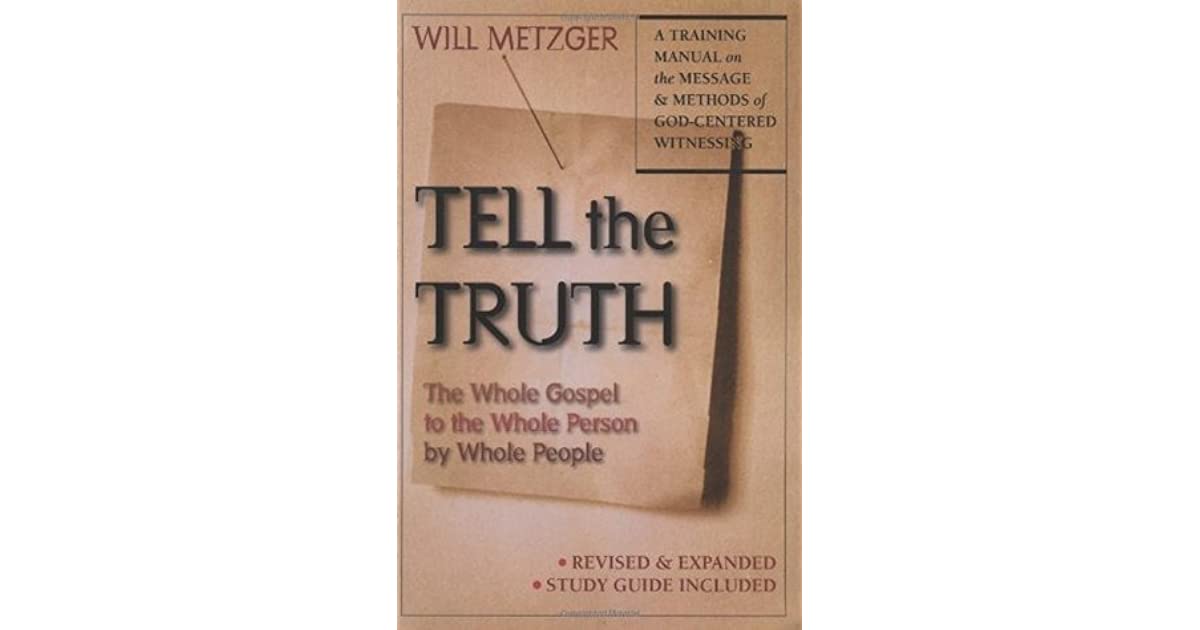Yesterday, I gave a brief overview of Will Metzger’s book on evangelism, Tell the Truth: The Whole Gospel to the Whole Person by Whole People. Today, I am going over some of the strengths and weaknesses of Metzger’s book.
Strengths
Overall, Tell the Truth is a valuable book for Christians who desire to be faithful in personal evangelism. One of the strengths of this book is Metzger’s ability to make careful distinctions.
For example, Metzger is right to point out the difference between sharing a personal testimony and testifying about Christ (28). He understands the value of a personal testimony, and yet carefully distinguishes between telling “your story” and telling Christ’s story.
Metzger is also right to see the call for response as an integral part of the gospel proclamation. While the call to repentance and faith may not necessarily be “gospel” itself, a gospel presentation is surely lacking if it gives no instructions for sinners to respond (77-9). Over against some Calvinists who refrain from calling for a response, Metzger rightly understands the biblical imperative that must be issued to those who hear the gospel.
Another strong point is balance. For example, Metzger combines the truth of Christ’s exclusivity with the radically inclusive call to salvation (164), thereby avoiding the trap of fostering an attitude of religious superiority.
Metzger also strikes a good balance between formulaic evangelism and strategic methods and diagrams. He understands the helpfulness of evangelistic tools, yet resists the tendency to rely on only one specific method.
The appendices are likewise very helpful to those who wish to consistently engage in personal evangelism.
Weaknesses
There are a few weaknesses in Tell the Truth, though these in no way detract from the overall value that Metzger’s book provides for evangelicals.
The first weakness is one that is common to evangelistic strategies in the evangelical world: the absence of the church. It is unfortunate that in the simplified version of the “Come Home” diagram (54), Metzger does not mention the church at all.
The evangelistic strategy is exclusively vertical in nature, so that the unsaved person hears a message that is only about a personal relationship with God. The horizontal dimension of the good news (God creating a covenant community for his glory and the good of the world) is missing from this picture. To his credit, Metzger does include the invitation into the family of God in a couple of other places (126), but the church is not seen as the primary platform upon which salvation is taking place.
Despite the good emphasis on true regeneration and personal conversion resulting from complete gospel presentations, Metzger’s proposal does not go far enough. Because of its absence within the overall structure of the gospel presentation, the church will inevitably seem like a theological afterthought or the practical “fine print” at the bottom of a gospel presentation rather than the integral part of the picture it truly is.
Whereas the Bible’s storyline presents us with God as a good Creator determined to redeem his fallen creatures and restore his fallen world, Tell the Truth focuses exclusively on the individual side of this equation. The person who hears this gospel presentation rightly understands his unworthiness before a holy God, but does not hear an explanation of the overarching framework into which his personal story must fit.
There are a few other weak spots in the book.
Because of the exclusive focus on the individual, Metzger sees guilt as the primary problem that Christ came to deal with (67). Guilt is indeed a problem resolved by the cross, but would not “death” be primarily what Christ came to deal with (Rom. 6:23)? Were Metzger to have emphasized the problem of “death” over “guilt,” his understanding of the resurrection and the future hope of Christians would have been greatly sharpened.
Another weakness is due to oversimplification in Metzger’s description of “me-centered theology.” At one point, he basically equates Arminians and Pelagians (109), a move which would surely ruffle the feathers of most Arminians (who would stand side-by-side with Augustine against Pelagius any day).
Also, to illustrate the doctrine of irresistible grace, he tells a story that makes it sound like people come to faith apart from and despite their will (144).
Conclusion
Tell the Truth is one of the best evangelical books on personal witnessing that you will find. It rightly points out the dangers of shrinking the Bible’s teaching on salvation and brings us back to the core of the gospel in order to reestablish our passion for evangelism.
Despite a few flaws, Tell the Truth helpfully centers our evangelistic efforts upon God and his glory.
